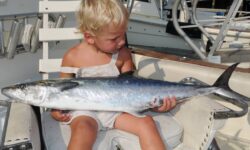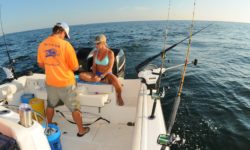From Ponce to St. Mary’s Inlets, pogy migrations along the beaches and inlet mouths attracting a variety of pelagic saltwater species, where near shore fishing is simply awesome.
Fishermen are frequently asked, “If you had one lure to fish with and for a variety of saltwater game fish, what lure would you choose?”
More than likely the lure of choice would be a spoon. Spoons have an erratic swimming action and flash that promotes strikes from even the wariest of game fish. My question is, “If you had a choice of fishing with only one live baitfish, what specie would you choose?”
If you’re targeted fishing waters includes Florida’s “Gold Coast”, you’re live bait of choice would more than likely be the versatile “Pogy”. Also frequently called menhaden, pogies begin schooling in tidal estuaries, inlets and along the beaches during early March and found in excellent numbers during the warmer months of June, July and August. The main migration begins to thin out as cooling water temperatures of early fall find a menhaden migration going south and out to deeper water.
The amount of recent rainfalls is a determining factor where fishermen will more than likely find pogy schools during the early hours of their fishing day. While it isn’t unusual during extreme dry conditions to find menhaden schools in nearby tidal rivers. With normal rainfall, pogy schools can be located at the mouths of inlets and along the beaches where tides carry plankton rich waters from marshes into the open ocean.
Gold Coast fishermen have found that thickly schooled pogies are easy to locate and often found schooling in there targeted fishing waters. Unlike sharing the locations of quality game fish, fishermen are more than willing to share the locations of pogy schools with other fishermen. Be sure and monitor your VHF marine radio for current locations of menhaden schools.
One of the easiest methods for locating pogy schools is to call or visit your local bait & tackle shop the day before and ask for information on recent pogy schools. Charter boats captains that fish on a day to day basis also offer a great venue of information concerning pogy school locations. Once out on the water, look for diving pelicans, or fishing boats in the distance with cast netters on the bow.
Motor slowly up to the school of pogies with the wind on your stern and shut your engine off just outside of cast net range. Pogies will typically swim into a wind driven current, or tide. An eight to ten-foot cast net with a 3/8th inch mesh, is more efficient when netting pogies. Be sure and employ a long cast net rope that allows the net to sink all the way to the bottom. In some cases when pogies are not schooling on the surface, you will need to locate pogies with your fish finder. Here, pogy schools are typically found schooling from just under the surface to the bottom.
Once seasoned fishermen have filled their boat’s live well with pogies, they have the satisfaction of having on board extremely versatile live baits that are deadly for many species of Northeast Florida saltwater game fish.
Small boaters that compete in Northeast Florida kingfish tournaments are frequently referred to as the “Mosquito Fleet”. However there is nothing small about the baits they fish with and the giant king mackerel they target. Kingfish tournaments can draw up to 600-boats where the majority of boats measure less than 25-feet. The attraction for small kingfish boats relates to big migrations of kingfish along the beaches and inlet mouths. And the availability of the mackerel’s number one forage food, the nutritious pogy.
“We have everything that a large kingfish boat has, except everything we have is smaller”, Bob Johnson said. “We have a 22-gallon live bait well that holds up to 22- pogies, or one pogy for every gallon of water. A 500 GPH Rule live bait well pump is secured to the transom of our kingfish boat and easy to replace when the pump goes bad.”
During the “2009 Nassau Sports Fishing Association’s Tournament of Champions”, Bob Johnson teamed up with Keith Lane of Yulee, Florida and took top honors. They won the event while fishing from one of the smallest boats entered in the popular kingfish tournament, a Mercury powered 17-foot Boston Whaler, called “Traveler”.
At 9:30 AM, during the final day of the two day event, a massive king mackerel struck a live pogy fished in the Mercury outboard’s “WheelWash”. Followed by a non typical kingfish fight, a 48.64-pound king mackerel was gaffed and won the event for the two skilled king fishermen.
Without saying, one of the most efficient live bait trolling techniques for Northeast Florida king mackerel involves trolling with the largest live pogy from your live well and right in your motors wheel wash. The standard kingfish leader begins with a 30-pound black barrel swivel, haywire wrapped to a 4-foot section of 31-pound coffee colored, single strand piano wire. Next, a black VMC #4-4X treble hook is haywire wrapped to the remaining tag end of the leader wire. Haywire wrap an eight-inch section of 43-pound coffee colored, single strand piano wire to the eye of the “Nose” treble hook. Finally a black VMC #4-4X treble hook is haywire wrapped to the tag end of the “Stinger” wire adjusting the length so that the stinger hook lays just ahead of the pogy’s tail.
“During the many years of running Southern Kingfish Association” events, I have found that the most popular technique for taking winning king mackerel, is trolling with a “Double Pogy” kingfish leader,” SKA’s Managing Partner, Jack Holmes said. “The double pogy leader gives kingfish a larger baitfish presentation to look at and also a better chance of a solid hookup with multiple hooks.”
The “Double Pogy” leader is made up the same exact way as a “Single Pogy” leader. However a second section of 43-lb. stinger wire is haywire wrapped to the eye of the stinger treble hook with a third black VMC #4-4X treble hook haywire wrapped to the final end of the second stinger wire. The first and larger pogy is nose barbed to the first treble hook and a smaller pogy is barbed through the nose of the second treble hook. The third treble hook is allowed to lay just ahead of the tail of the second pogy.
The larger pogy trolled ahead of the smaller pogy keeps the “Double” pogy leader from tangling as the larger pogy swims stronger than the smaller one.
Single and double pogy live bait leaders are deadly when trolled as “Flat Lines” far back in the trolling spread from 30-80 feet, in the “Wheel Wash” and deep with the aid of downriggers. Kingfish leaders are typically rigged to 20-pound class live bait rods with high speed kingfish reels filled with 300-400 yards of twenty pound monofilament line. A 15-20 foot section of 20-30 pound fluorocarbon shock leader is attached to the main line and the swivel of the kingfish leader.
Through the years, king mackerel fishermen steadily improved their techniques for “Pogy” fishing. And soon found that their favorite kingfish baits, when rigged properly, were also excellent baits for a wide variety of “Gold Coast” game fish. Live bait trolling with pogies frequently attracted game fish strikes from dolphin, sailfish, tuna, barracuda, cobia, Spanish mackerel amberjack and the fast swimming wahoo.
“I have chartered my clients to king mackerel up to 50-pounds,” Captain Terry David Lacoss said. “However that 93-pound wahoo that ate a “Double Pogy” live bait leader, was the best that I can remember.”
Like many coastal and offshore charter and recreational sports fishermen, Terry David has learned how to become versatile while fishing with pogies, and for a wide variety of game fish.
“Our first choice of securing live baits is cast netting pogies,” Captain Terry David Lacoss said. “Departing from my home Port of Amelia Island, pogies often school right in the deep waters of the Amelia River, particularly when there has been a lack of rainfall. A second option would be to cast net pogies at the St. Mary’s inlet, or along the beaches. Once we have filled our live wells with 50-70 live pogies, we will navigate offshore and slow troll live pogies over live bottoms for striking game fish. Slow trolling pogies from a typical trolling spread produces constant action from a wide variety of Northeast Florida striking fish. I am confident that when our live wells are brimming with live pogies, a successful day of live bait trolling is soon to follow.”
While many live bait trolling boats target a variety of striking game fish, both live and dead pogies also afford for excellent bottom baits as well.
Anchoring, or drifting over your favorite Northeast Florida kingfish ledge while fishing dead on the bottom with live, or dead pogies, is a deadly bottom fishing tactic. In fact a major scent factor plays and important roll in attracting grouper, red snapper, triggerfish, cobia, amberjack and more to the fish-oil rich pogy.
The terminal pogy bottom setup begins with a 4-foot section of 80-100 pound fluorocarbon shock leader attached to the terminal fishing line using back to back uni knots. Next, a 6-8 ounce egg sinker is threaded onto the terminal fishing line. Finally a 5/0 to 7/0 circle, or kahle hook is tied to the tag end of the shock leader and the pogy barbed right through the bottom of the mouth and up through the top of the mouth. This is referred to as a “Knocker” rig where the weight holds the live or dead pogy, dead on the bottom.
Northeast Florida tarpon fishermen have found that pogies afford for excellent tarpon baits both live and dead, when fished either on the surface, or down deep in the water column. The most popular style of tarpon fishing begins with cast netting a live well full of menhaden, then filling a 100-quart cooler with dead pogies.
Tarpon fisherman then set up a chum slick with floating and cut pieces of pogies as they drift along the beaches with the wind and tides. Grinding pogies with an on board meat grinder and placing the ground chum in a mesh bag off from the gunnel is also an excellent chumming tactic. Barbed pogies are drifted in the chum slick with 20-40 pound tackle using an 8-foot section of 100-pound fluorocarbon shock leader and a 7/0 circle hook tied to the business end of the shock leader. Once again live pogies are barbed through the bottom of the mouth and out through the top of the mouth and either fished on the surface with the aid of small floats attached to the terminal fishing line, or allowed to drift just under the surface without weights or floats.
Targeting pods of pogies along the beaches is also an excellent and exciting technique for hooking up to tarpon, cobia, redfish and a wide variety of beach sharks. Here beach fishermen look for schools of pogies along the beaches that are under siege by game fish. The obvious signs include pogies showering the surface, or game fish striking pogies in the school. A tried and true angling tactic includes using a 20-30 pound spinning rod and reel setup with an 8-foot section of 80-pound fluorocarbon shock leader and 7/0 circle, or kahle hook. Once again the pogie is barbed right through the bottom of the mouth and out through the top of the mouth, then cast into the middle of the pogy school and allowed to drift down to the bottom where most strikes occur.
Inlet fishermen often anchor their boat at the mouths of inlets and fish dead on the bottom with either live or dead pogies with excellent success as well. Here 30-50 pound class tackle is employed with a “Fish Finder” threaded onto the main line. Here fishermen can attach a 4-8 ounce pyramid weight to the fish finder snap, using just enough weight to keep the pogy on the bottom. An 8-foot section of 80-pound fluorocarbon leader once again is attached to the main line and a 6/0 – 7/0 circle or kahle hook is tied to the tag end of the shock leader. Live or dead pogies are barbed through the bottom of the mouth and out through the top of the mouth and fished dead on the bottom.
This deadly inlet pogy technique produces rod bending action for tarpon, redfish, cobia and sharks. Drifting live pogy with a single pogy kingfish leader close to the surface will also attract such game fish as king mackerel and cobia.
Menhaden spawn during the spring at inlet mouths where fertilized eggs are carried into the backwater tidal estuaries and bays. During late summer, small pods of maturing pogies can be seen schooling over flooded flats and in deep channels in the backwaters. With this in mind, these small pre-adult pogies become excellent forage foods for redfish, jack crevalle, flounder, bluefish and sea trout.
Here in the backwater bays and rivers, drifting a pogy under a “Popping” cork is a deadly technique for all of the above mentioned species. Terminal fishing tackle includes a 7.8-foot, 20-pound class spinning rod with the reel spooled with 20-pound braided fishing line. An 8-foot section of 20-pound fluorocarbon shock leader is tied to the terminal fishing line and a #1 kakahle hook is tied to the tag end of the shock leader. The popping cork is attached to the shock leader some 12-18 inches above the hook. Finally the live pogie is barbed through both nostrils and drifted under the popping cork.
Live pogies can also be fished successfully on the bottom and close to oysterbars while barbing the pogie with a 1/8th ounce jig from the bottom of the mouth right out through the top of the head. Work the jig and pogie combo slowly along the bottom for flounder and redfish.
Certainly the big attraction for pogie fishing along Northeast Florida’s “Gold Coast”, is their abundance and fish attracting smell.










